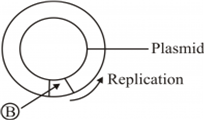 Short Answer Type
Short Answer Type(a) Identify (A) and (B) illustrations in the following:
i. 
ii. 
(b) Write the term given to (A) and (C) and why?
(c) Expand PCR. Mention its importance in biotechnology.
Rearrange the following in the current sequences to accomplish an important biotechnological reaction :
(a) In vitro synthesis of region of DNA of interest
(b) Chemically synthesized oligonucleotides
(c) Enzyme DNA-polymerase
(d) Complementary region of DNA
(e) Genomic DNA template
(f) Nucleotides provided
(g) Primers
(h) Thermostable DNA-polymerase (from Thermus aquaticus)
(i) Denaturation of ds-DNA
Why is it not possible for an alien DNA to become part of a chromosome anywhere along its length and replicate normally?
Name the enzymes that are used for the isolation of DNA from bacterial and fungal cells for recombinant DNA technology.
The enzymes that are used for the isolation of DNA from bacterial and fungal cells for recombinant DNA technology are:
Lysozyme is used to isolate DNA from bacteria.
Chitinase is used to isolate DNA from fungus.
Name and describe the technique that helps in separating the DNA fragments formed by the use of restriction endonuclease.
 Long Answer Type
Long Answer Type(a) Describe the various steps of Griffith’s experiment that led to the conclusion of the ‘Transforming Principle’.
(b) How did the chemical nature of the ‘Transforming Principle’ get established?
